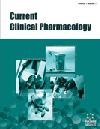- Home
- A-Z Publications
- Current Clinical Pharmacology
- Previous Issues
- Volume 2, Issue 1, 2007
Current Clinical Pharmacology - Volume 2, Issue 1, 2007
Volume 2, Issue 1, 2007
-
-
Misoprostol for the Treatment of Early Pregnancy Failure
More LessNearly 20% of all pregnancies end in early pregnancy failure, and surgical evacuation of retained products of conception is often used to manage this failure. Misoprostol is an inexpensive, stable analog of prostaglandin E1, and is powerful at contracting the uterus. With intravaginal misoprostol, the peak plasma levels are lower, but the levels after 4 hours are higher, than after oral or sublingual administration. With Read More
-
-
-
Warfarin Dosing and the Promise of Pharmacogenomics
More LessAuthors: Todd E. Dumas, Roy L Hawke and Craig R. LeeDue to its narrow therapeutic index and substantial inter-patient variability in clinical response, warfarin represents an ideal drug candidate to benefit from the promise of pharmacogenomic-guided dosing strategies. Consistent with in vitro data, clinical studies have demonstrated that CYP2C9 polymorphisms significantly influence warfarin pharmacokinetics by reducing (S)-warfarin metabolic clearance, consequently lo Read More
-
-
-
Determinants of Drug Metabolism in Early Neonatal Life
More LessAuthors: Karel Allegaert, John N. van den Anker, Gunnar Naulaers and Jan de HoonClinical pharmacology intends to predict drug-specific effects and side effects based on pharmacokinetics (i.e. absorption, distribution, metabolism and elimination) and pharmacodynamics (i.e. dose/effect relationship). Developmental pharmacology focuses on the maturational aspects of these phenomena during perinatal life and later stages of infancy. In general, phenotypic variation in drug metabolism is based on constitution Read More
-
-
-
The True Face of the Revolution in Oncology Drug Development: A Personal Reflection
More LessAuthors: Michael Burgess and Dinesh P. de AlwisThe majority of drugs approved for the treatment of malignant disease are traditional cytotoxic agents that, in many cases, have been in use for decades. In the recent past, we have seen the approval of the so-called targeted agents and with this have emerge concepts such as biomarker and optimal biological dose, but which came first and what is actually behind the paradigm shift that is all too evident in modern oncolog Read More
-
-
-
Clinical Pharmacokinetics of Systemically Administered Antimycotics
More LessSystemic fungal infections are a major threaten for immunocompromised patients. Beside the antimycotic spectrum, the pharmacokinetic properties of an antifungal drug are crucial for its clinical efficacy. Since patients with systemic mycoses frequently present with a significant co-morbidity, pharmacokinetics under special conditions such as renal insufficiency, renal replacement therapy or impaired liver function h Read More
-
-
-
Immunomodulatory Therapy Associated to Anti-Parasite Drugs as a Way to Prevent Severe Forms of Malaria
More LessMalaria is an important problem of public health. It is estimated that 350 to 500 million clinical cases occur annually, which cause 1.1 and 1.3 million deaths every year. The excessive activation of the immune system plays an important role in the pathogenesis of the disease. The cells of the immune system of Plasmodium-infected individuals not only produce large amounts of cytokines, which have anti-parasite effects, but al Read More
-
-
-
Busulphan in Blood and Marrow Transplantation: Dose, Route, Frequency and Role of Therapeutic Drug Monitoring
More LessAuthors: Christa Ellen Nath and Peter John ShawBusulphan (Bu) is an alkylating agent that, when combined with agents such as cyclophosphamide (Cy), ablates the bone marrow prior to blood or marrow transplantation. There is wide inter- and intra- patient variability in Bu pharmacokinetics. Early pharmacodynamic studies suggested a significant relationship between high Bu exposure and the occurrence of veno-occlusive disease of the liver, but were not performed in Read More
-
-
-
The Pharmacogenetics of CYP2C9 and CYP2C19: Ethnic Variation and Clinical Significance
More LessAuthors: J. Rosemary and C. AdithanCYP2C9 and CYP2C19 are important drug metabolizing enzymes and together metabolize about 18% of currently available drugs. Some of the important groups of drugs that are metabolized by them are antihypertensives, hypoglycemics, anticonvulsants, antiulcer drugs etc. Genes encoding these enzymes are polymorphically expressed. Thirty variant alleles for CYP2C9 and 21 for CYP2C19 have been reported. The Read More
-
Most Read This Month
Article
content/journals/ccp
Journal
10
5
false
en


